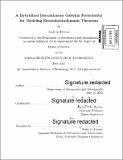A hybridized discontinuous Galerkin formulation for modeling electrohydrodynamic thrusters
Author(s)
Dexter, Andrew (Andrew Joseph)
DownloadFull printable version (9.684Mb)
Other Contributors
Massachusetts Institute of Technology. Department of Aeronautics and Astronautics.
Advisor
Steven R. H. Barrett.
Terms of use
Metadata
Show full item recordAbstract
Electrohydrodynamic (EHD) thrusters utilize ion neutral collisions in air to produce a propulsive force. The ions are generated at an emitting electrode in an asymmetric capacitor by a corona discharge. This thesis presents a Hybridized Discontinuous Galerkin (HDG) formulation for solving the EHD thruster governing equations with the exception of fluid flow equations. The problem is two-way coupled and non-linear. A smoothed charge injection model from the literature for the corona discharge is included in the HDG scheme. The formulation is validated against a model problem which has an analytical solution and parallel wire single stage and dual stage thruster performance data from the literature. The model problem consists of concentric cylinders with charge density and potential specified on the inner and outer cylinders. The inner cylinder is offset to test the charge injection boundary condition in an asymmetric solution. The single stage thruster consists of two parallel wires of different diameters separated by a 1 cm gap. The dual stage thruster consists of three inline parallel wires of different diameters separated by 1 cm and 3 cm. The HDG solution for the model problem is found to produce normalized errors on the order of 10-3 for the potential and charge density solutions. The charge density applied to the inner emitter electrode is increased over several solution iterations to resolve high charge density gradients. The charge density boundary condition applied to the offset case represented the expected qualities of a corona discharge. The smoothed boundary condition is shown to be tunable to allow for a trade-off between accuracy and numerical stability. The single stage thruster model replicated experimental thrust results within 14% error using homogeneous charge injection and the smoothed charge injection model requires a less stable setting to achieve similar accuracy. The dual stage model shows the necessity of a mixed outflow boundary condition to avoid non-unique solutions.
Description
Thesis: S.M., Massachusetts Institute of Technology, Department of Aeronautics and Astronautics, 2015. Cataloged from PDF version of thesis. Includes bibliographical references (pages 93-97).
Date issued
2015Department
Massachusetts Institute of Technology. Department of Aeronautics and AstronauticsPublisher
Massachusetts Institute of Technology
Keywords
Aeronautics and Astronautics.